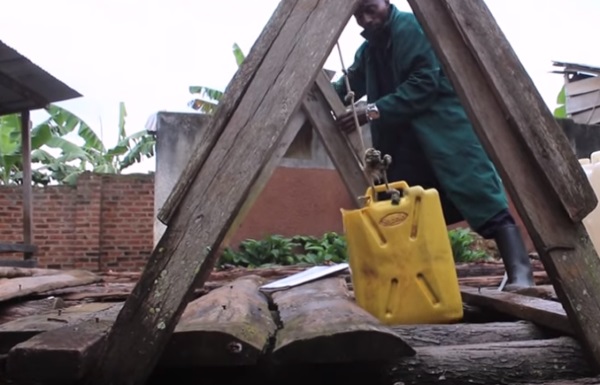The prolonged dry spell that hit the country from September 2016 to February this year left approximately 10.9 million Ugandans in urgent need of food relief. Climate change resulted in drought, food shortages, and hunger. Godfrey Mujuni of Uganda Metrological said farmers should brace themselves for another dry spell between January and February 2018. “January and February are dry months so we expect dry conditions to prevail over the whole country. Apart from a few isolated areas where you will get one or two rain days influenced by local patterns.” Said, Godfrey Mujuni – Data Manager, Uganda National Metrological Authority.
Many farmers depend on dairy in rain for food security. At St., Jude Farm Busenze in Masaka district the solution for the dry spells was found 7 years ago by harvesting both running water and from the roofs when it rained. “So we have runoff water harvesting and roof-off water harvesting.” Alexander Amapire one of the farmers here said it was possible for every farmer to harvest water. “You see the runoff water where it comes from then you target also where you are going to put your pit or your hole.”
The process starts with digging a pit which you then cover with polythene. “So if you see how the water moves then you can see where to put the pit and where there is a destination of your water.” Said Amapire. It is important to ensure safety so he emphasizes that it is covered by logs or bricks which will also help when one is collecting water. “These poles also help you to cover the underground tank, this also helps to avoid accidents because somebody can fall in or your animal can fall in or your visitor.” But before the pit is dug, the farmer must ensure it is located in an area where there is running water. The next step is to fill the pit with stones which will help to filter the water. One can also use wire mesh which can help keep the water clean and pure until the time for use.
In addition to running water, Amapire also harvests rainwater from the roofs. This is stored in the same pit. He said the 5,000 liters capacity pit costs 600,000 shillings to construct and have served him well for the last 7 years. Amapire advised that any farmer can have one though it depends on their finances. The farmer said the water has been extremely helpful during the dry season. “In a dry season, our crops are very healthy, very beautiful because we do irrigation with this surface water.”
Masaka district Agricultural officials said this method of water harvesting is favorable for both commercial and small-scale farmers. Harris Kakooza said the dry spell affects many of their farmers and they are campaigning that each one adapts a system like this. “In plan; is to put up demonstration sites in a number of places. With this kind of intervention, if we put up the demos in different places; those can be used as training centers.”
Sam Mulwana another farmer in Luwero district stores his water in an underground tank and it is these that help to irrigate his banana plantations. “And I really saw almost my crops shading away because of the drought but I said I should not give up because when you are in food production the market is always there. So that’s why I tried to come up with such medium kind of technology to provide water so that I can water these banana plants.” Said, Sam Mulwana – Farmer. Mulwana said he spent 4 million shillings and said he did not regret his investment. “Because when I sit to calculate it cost me between 4 to 5 million shillings which money I can say is affordable and which is not affordable to most of our farmers especially in the rural areas so maybe, in summary, I may say it is not affordable to everybody.”
“So we try to encourage the people to take the technology that is appropriate for their need in terms of demand, in terms of their expertise and financial capacity to handle.” Said, Eng. Ronald Kato Kayizzi – Commissioner, Water for Agriculture Production. Ronald Kato Kayizzi, a Commissioner in the Ministry of Agriculture says the government will construct 200 valley dams across the country to ensure farmers have access to water for agriculture. This is will be under the Climate Smart Agriculture Project. “Whereby you conserve, you mulch your garden, you don’t let any single drop of water that falls on your plot to run away. So with that, you may not even need to irrigate.”
But the Agriculture Minister Vicent Sempijja said despite numerous interventions, it is advisable for every farmer to get their own water because not everyone will have access to the dams. “Most of the work will be done by the farmers, the government is going to avail and come in and close those gaps where really the farmers cannot manage.” The farmers hope the government can play a pivotal role to ensure access to water for all of them.

